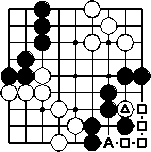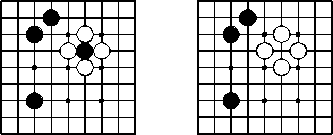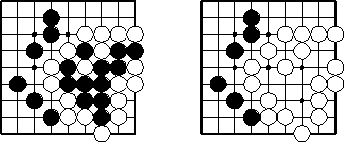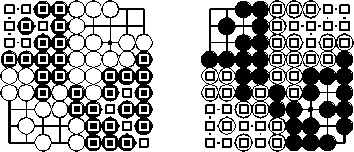2024-05-23 last update, 1997-2-4 first day, Robert Jasiek
Commentary on Tromp-Taylor Rules
These very simple and logical go rules are known as
Tromp-Taylor rules.
The game is played on a square grid by two players
called black and white.

square grid
- This grid has 9x9 grid points.
- Paths of grid lines are between any two grid points.
- This is the outset.
- The game is played by two players. Each player has a color:
black respectively white.
Each grid point may be black, white, or empty.

grid points with colors black, white, or empty
- Two players compete using black respectively white color.
- Grid points without black or white have empty color.
If a path along the grid lines leaves a grid point A, passing
only grid points of A's color, to end at a grid point of color C, then
A is said to reach C.

grid point A reaches white
- A path along grid lines leaves the grid point A, passes the
squared grid points, and ends at the triangled grid point.
- The grid points A and squared all have the empty color of A.
- The triangled grid point has white color.
- The grid point A reaches white.

A, B, C reach white
- Each of the grid points A, B, and C reaches white.
- The grid point D does not reach white.
- All four grid points reach empty.
- B, C, and D also reach black.
- A does not reach black.

A reaches black
- The grid point A reaches black using a short path.
- A also reaches empty.
Clearing a color is the process of emptying all grid
points of that color that do not reach empty.

clearing black
- The black grid point near to white grid points does not reach
empty. Thus it is to be cleared.
- After clearing the grid point is empty.

clearing black
- Several black grid points do not reach empty. They all become
cleared.
- After clearing the grid points are empty.
The players alternate turns, starting with black.

black starts, then both players alternate
A turn gives a player the right to move by coloring an empty
grid point with his color, then clearing the opponent's color,
then clearing his color.

white's turn is a move at 1
- Most turns are used for a move.
- White uses his right to move by coloring the empty grid point 1
white.
- Black needs no clearing then.
- White needs no clearing then, either.
- Often no clearing at all occurs.

white's turn is a move at 1
- White moves at 1, making the empty grid point white.
- Then black is cleared: One black grid point becomes empty.
- Then white needs no clearing.
- A move can include clearing of one color only.

white's turn is a move at 1
- White moves at 1, making the empty grid point white.
- Then black is cleared: Several black grid points become empty.
- Then white needs no clearing.

black's turn is a move at 1
- Black moves at 1, making the empty grid point black.
- Then white needs no clearing.
- Then black is cleared: Three black grid points become empty.
- Such suicidal clearing rarely occurs.
No move may repeat an earlier grid coloring.

2 repeats an earlier grid coloring and is not allowed
- If black played at 2 after white's 1, then the grid coloring
before 1 would be repeated.
- Black may not play at 2 right now. He is required to use his
turn differently.
- Black might get a chance to play at the grid point 2 later.
A turn may be a pass. Two consecutive passes end the game.

white's turn 1 is a pass - black moves at 2 - white's turn 3 is a
pass - black's turn 4 is a pass
- White has the turn
but no useful move. Therefore white uses his turn 1 to pass.
- Black still has a useful move: he moves at 2.
- Black 2 is the last move coloring a grid point.
- Black 2 prepares the grid for scoring by clearing white.
- After 2 no player can increase the number of empty grid points that
do not reach the opponent's color.
- The turns 3 and 4 are both passes. They are played consecutively
and thus end the game.
At the game end a
player's score is the number of grid points of his color plus
the number of empty grid points not reaching the opponent's color.
The higher score wins.

black score - white score
- The black score consists of the black grid points and the
empty grid points not reaching white.
- Black's score is 40.
- The white score consists of the white grid points and the
empty grid points not reaching black.
- White's score is 41.
- White has the higher score and wins the game.

black score - white score
- Black's score is 44.
- White's score is 35.
- Black has the higher score winning the game.
- The two empty grid points reaching black and white score
for neither player.

















